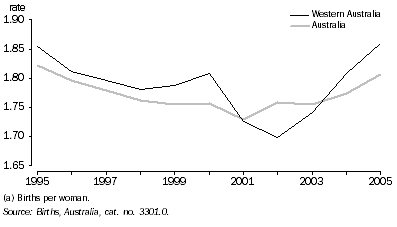 SOCIAL TRENDS
SOCIAL TRENDS
FAMILIES AND HOUSEHOLDS
Marriages and divorces
In 2005, 11,100 marriages were registered in Western Australia, representing an increase of 500 (4.9%) from 2004. Western Australia was the only state or territory to record an increase in registered marriages. The crude marriage rate (the number of marriages per 1,000 of the estimated resident population) for Western Australia also increased from 5.4 in 2004 to 5.5 in 2005. However, this remained lower than the rate in 1995 (6.0). For almost two thirds (65.8%) of marriages in Western Australia, both partners were marrying for the first time. This compares to 68.0% nationally. The median age at first marriage for both males and females continues to increase in Western Australia. In 2005, the median age was 30.3 years for men and 28.3 years for women. In 1995, the respective median ages at first marriage were 27.5 and 25.5 years.
In Western Australia, there were 5,300 divorces in 2005. The crude divorce rate (the number of divorces per 1,000 of the estimated resident population) declined from 2.9 in 1995 to 2.6 in 2005. The median duration between marriage and divorce has increased from 8.8 years in 1995 to 9.5 years in 2005. This compares to 8.8 years nationally in 2005.
Fertility
There were 26,300 births registered in Western Australia in 2005. This was 3.8% higher than in 2004 (25,300 births) and 8.2% higher than in 2003 (24,300 births). The total fertility rate (TFR) represents the number of babies that a woman could expect to bear during her reproductive lifetime based on current age-specific fertility trends. The TFR in Western Australia has generally decreased over a long period falling to a low of 1.70 in 2002. Since then, however, it has increased to some extent, reaching 1.81 in 2004 and 1.86 in 2005. Apart from a short period between 2001 and 2003 the TFR for Western Australia has been higher than for Australia over the past decade.
TOTAL FERTILITY RATE(a)

A significant trend over many years has been the increase in births to mothers aged 35 years and over. In Western Australia, the proportion increased from 12.8% in 1995 to 19.7% in 2005. There has been little change in the proportion of births to mothers aged under 20 over the same period (6.0% in 1995 and 5.5% in 2005).
Families and work
In June 2006, 11.6% of children under 15 (47,200) in Western Australia were living in families where no parent was employed, decreasing from 15.7% in June 1996. Over the same period the proportion of couple families with neither parent employed fell from 7.1% to 3.5%. More than half (57.1%) of couple families with children aged under 15 in Western Australia had both parents employed. The proportion of couple families where this is the case has increased steadily from 50.3% in 1996. The proportion of lone parent families where the parent is employed increased from 47.5% to 57.5% over the same period.
 Print Page
Print Page
 Print All
Print All